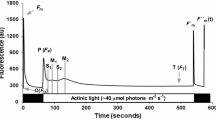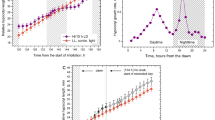Abstract
External parameters (e.g. light/dark alterations and temperature) were tested for their ability to influence the expression pattern of the chlorophyll a/b binding protein (cab) genes and the small subunit of RuBPC/Oase (rbcS) genes. Particular interest was focused on the alterations of diurnal/circadian oscillation patterns of cab mRNA levels.
Chlorophyll a/b binding protein and small subunit of RuBPC/Oase mRNA oscillations were observed in tomato seedlings grown without environmental perturbations (constant illumination and temperature), indicating that these genes are controlled by an endogenous rhythm. The rhythmic fluctuation patterns revealed a period of about 32 hours and a weakly expressed amplitude. A several-fold increase of the cab mRNA amplitude and a reduction of the period to about 24 hours (circadian) was monitored after exposure of the tomato seedlings to 3, 6 or 9 hours of darkness. The elevated amplitude disappeared at consecutive days if seedlings were not exposed to further dark phases. A circadian rhythm with clearly expressed cab mRNA amplitudes was also present after the plants had been transferred to darkness at various circadian times. However, under those circumstances the time points of maximum and minimum transcript levels were shifted by respective hours.
Alteration of the growth temperature from 24°C to 10°C or 30°C at constant illumination or in a light/dark cycle resulted in a reduction of the amplitudes or of the steady-state mRNA levels. Such extreme temperature changes do not induce or enhance the diurnal cab mRNA oscillations.
Similar content being viewed by others
References
Anderson CM, Wilkins MB: Period and phase control by temperarure in the circadian rhythm of carbon dioxide fixation in illuminated leaves of Bryophyllum fedtschenkoi. Planta 177: 456–469 (1989).
Arnon DI: Copper enzymes in isolated chloroplasts. Polyphenoloxidase in Beta vulgaris. Plant Physiol 24: 1–15 (1949).
Bünning E: Insight into the hereditary diurnal periodicity of the primordial leaves of Phaseolus multiflorus. Jahrb Wiss Bot 81: 411–418 (1935).
Bünning E: Endogenous daily rhythms as the basis of photoperiodism. Ber Deut Bot Ges 54: 590–607 (1936).
Bünning E: Endogenous, rhythms in plants. Ann Rev Plant Physiol 7: 71–90 (1956).
Feldman JF: Genetic approaches to circadian clocks. Ann Rev Plant Physiol 33: 583–608 (1982).
Galangau F, Daniel-Vedele F, Moureaux T, Dorbe M, Leydecker M-TH, Coboche M: Expression of leaf nitrate reductase genes from tomato and tobacco in relation to light-dark regimes and nitrate supply. Plant Physiol 88: 383–388 (1988).
Kellmann JW, Pichersky E, Piechulla B: Analysis of the diurnal expression pattern of the tomato chlorophyll a/b binding protein genes. Influence of light and characterization of the gene family. Photochem Photobiol, manuscript submitted (1989).
Kloppstech K: Diurnal circadian rhythmicity in the expression of light-induced plant nuclear messenger RNAs. Planta 165: 502–506 (1985).
Kuhlemeier C, Green PJ, Chua NH: Regulation of gene expression in higher plants. Ann Rev Plant Physiol 38: 221–255 (1987).
Meyer H, Thienel U, Piechulla B: Molecular characterization of the diurnal/circadian expression of the chlorophyll a/b binding proteins in leaves of tomato and other dicotyledonous and monocotyledonous plant species. Plant, 180: 5–15 (1989).
Nagy F, Kay SA, Chua NH: A circadian clock regulates transcription of the wheat cab-1 gene. Genes and Dev 2: 376–382 (1988).
Pichersky E, Bernatzky R, Tanksley SA, Breidenbach RW, Kausch AP, Cashmore AR: Molecular characterization and genetic mapping of two clusters of genes encoding chlorophyll a/b-binding proteins in Lycopersicon esculentum (tomato). Gene 40: 247–258 (1985).
Pichersky E, Bernatzky R, Tanksley SD, Cashmore AR: Evidence for selection as a mechanism in the concerted evolution of Lycopersicon esculentum (tomato) genes encoding the small subunit of ribulose-1,5-bisphosphate carboxylase/oxygenase. Proc Natl Acad Sci USA 83: 3880–3884 (1986).
Piechulla B, Pichersky E, Cashmore AR, Gruissem W: Expression of nuclear and plastid genes for photosynthesis-specific proteins during tomato fruit development and ripening. Plant Mol Biol 7: 367–376 (1986).
Piechulla B, Gruissem W: Diurnal mRNA fluctuations of nuclear and plasted genes in developing tomato fruits. EMBO J 6: 3593–3599 (1987).
Piechulla B: Plastid and nuclear mRNA fluctuations in tomato leaves-diurnal and circadian rhythms during extended dark and light periods. Plant Mol Biol 11: 345–353 (1988).
Piechulla B: Changes of the diurnal and circadian (endogenous) mRNA oscillations of the chlorophyll a/b binding protein in tomato leaves during altered day/night (light/dark) regimes. Plant Mol Biol 12: 317–327 (1989).
Salisbury FB: Time measurement and the light period in flowering. Planta 66: 1–26 (1965).
Satter RL, Galston AW: Mechanisms of control of leaf movements. Ann Rev Plant Physiol 32: 83–110 (1981).
Simon E, Satter RL, Galston AW: Circadian rhythmicity in excised Samanea pulvini. II. Resetting the clock by phyotochrome conversion. Plant Physiol 58: 421–425 (1976).
Simpson J, VanMontagu M, Herrera-Estrella L: Photosynthesis-associated gene families: Differences in response to tissue-specific and environmental factors. Science 233: 34–38 (1986).
Tavladoraki P, Kloppstech K, Argyroudi-Akoyunoglou J: Circadian rhythm in the expression of the mRNA coding for the apoprotein of the light-harvesting complex of photosystem II. Plant Physiol 90: 665–672 (1989).
Tobin E, Silverthorne J: Light regulation of gene expression in higher plants. Ann Rev Plant Physiol 36: 569–593 (1985).
Vince-Prue D: The perception of light-dark transitions. Phil Trans R Soc Lond 303: 523–536 (1983).
Vince-Prue D: The duration of light and photoperiodic responses. In: Kendrick RE, Kronenberg GHM (eds) Photomorphogenesis in Plants, pp. 269–305. Martinus Nijhoff/Junk Publishers, Dordrecht (1986).
Author information
Authors and Affiliations
Rights and permissions
About this article
Cite this article
Riesselmann, S., Piechulla, B. Effect of dark phases and temperature on the chlorophyll a/b binding protein mRNA level oscillations in tomato seedlings. Plant Mol Biol 14, 605–616 (1990). https://doi.org/10.1007/BF00027506
Received:
Accepted:
Issue Date:
DOI: https://doi.org/10.1007/BF00027506




